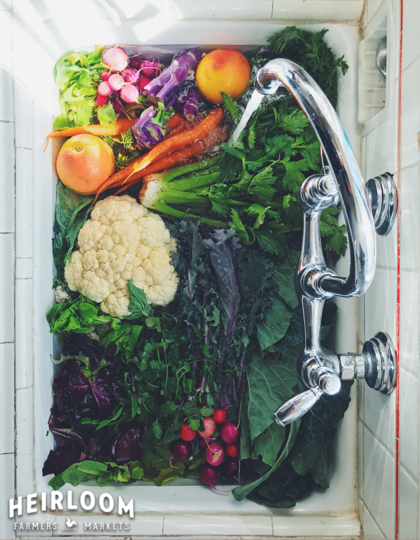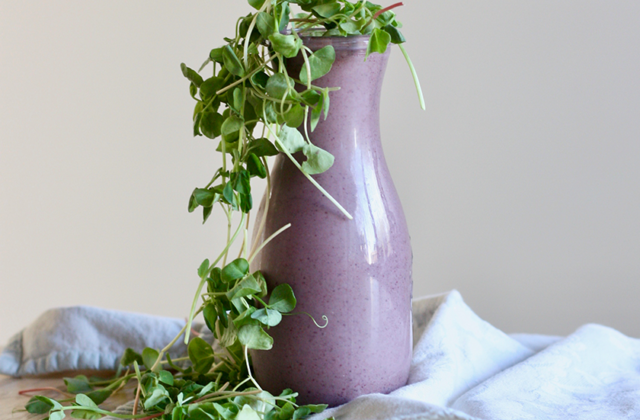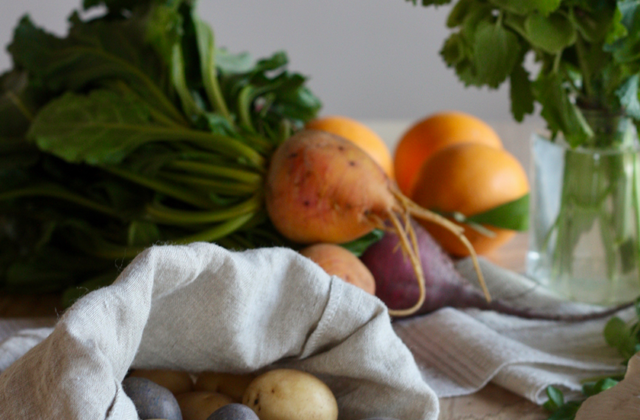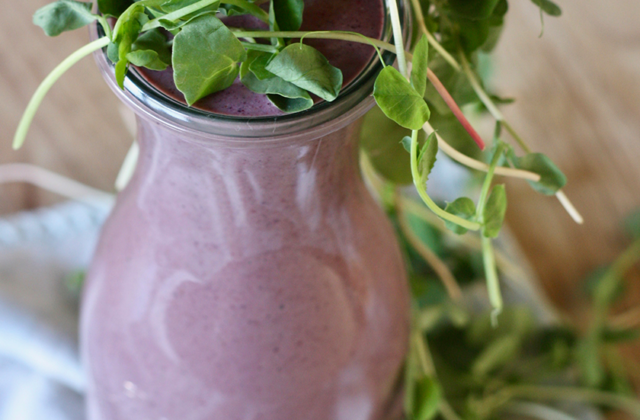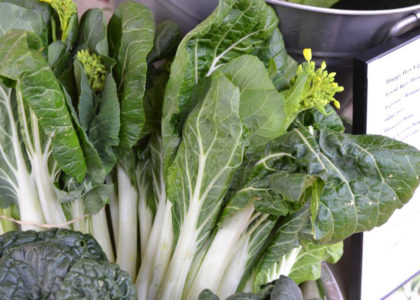Farm to Table Report – April 2018
What to Expect at the Farmers Market in April
As the temperatures continue to rise throughout the month of April, the most significant difference you’ll notice at the farmers market is the lack of once-abundant winter greens and citrus. Fear not––the kale, Swiss chard, and oranges that filled your fridge and belly for many months will soon be replaced by equally delicious spring vegetables, like asparagus, spring onions, carrots, beets, and crisp cabbage.
“Greens are pretty much done,” says James Montoya, of In the Beginning Farm. In the short interim between now and the Montoyas’ massive garlic harvest in May, James and his son Gabe will offer creamy new potatoes and garlic scapes at the market. Garlic scapes––long, green, and snake-like in appearance––are the flower bud of the garlic plant and taste like fresh, young garlic. “As soon as it gets hot, the scapes start shooting up,” Montoya says of the short-season crop, which will available by the end of April. This trendy crop can be used the same way you use garlic. To make scapes the star of the show, put them on homemade pizza before baking, grill them with olive oil, salt, and pepper to serve as a side dish, or whirl them into a garlicky lemon pesto. Whatever you do, take advantage of their short season––as quickly as they arrive, they’ll be gone.
Spring is in full swing at High Energy Agriculture, a two-and-a-half acre farm in Marana, where Anne Loftfield is harvesting sweet spring onions, celery, radishes, carrots, and leeks. Loftfield will offer more commonly found cured onions in May, but suggests that people take advantage of the young spring onions that are only around for a short time. Milder than cured onions, they should be stored in the refrigerator and can be grilled or roasted to be served as a side dish. “I try to encourage my customers to use everything on the vegetable,” Loftfield says, adding that the green stems on spring onions are perfectly edible and delicious.
In addition to spring produce like carrots, snow peas, fava beans, and cabbage, Maria and Miguel Quijada of Wild Child Gardens will offer their first summer squash of the year. They’ll also be selling homegrown flower bouquets, made up of fragrant bells of Ireland, sunflowers, and wheat stalks. After months of cultivating their newly purchased land and putting over 400 plants in the ground, the Quijadas are ecstatic to see everything come alive. “I’m excited about the tomatoes,” says Miguel. “When you plant as many [tomato] plants as we did and then see them actually fruiting, it’s amazing.” The Quijadas are currently growing 35 varieties of tomatoes, some of which will be available at the market in the next few weeks. If you feel inspired to make your own garden come alive, you can buy heirloom tomato, squash, melon, and basil starters from Wild Child Gardens throughout the month.
At Maggie’s Farm Lane in Marana, most of the produce is grown hydroponically, meaning it’s grown in a water solvent (as opposed to soil) using mineral nutrient solutions. As a result of being grown hydroponically, some of the produce from Maggie’s comes with the roots still attached. When you get home from the market, simply use a pair of kitchen shears to snip the roots before storing the produce. In April, Maggie’s will offer vibrant romaine, water cress, chard, spinach, tomatoes, basil, and cilantro, along with white and blue oyster mushrooms grown in their mushroom house. They’re also selling pomegranate and moringa trees that they’ve grown from seed. As it happens, early spring is a great time to get pomegranate and moringa trees in the ground.
April is a great time to plant other edible crops, too. At the market you’ll find plenty of warm-weather starters, which you can use to jumpstart your bountiful summer garden. When you need gardening advice, Heirloom Farmers Market has that, too. A plethora of knowledge sits behind the Master Gardeners booth at the Rillito Park market, where experienced gardeners from the UA Cooperative Extension’s Master Gardeners program wait to answer all of your questions about gardening in our unique desert climate. Use their seasonal planting guide to plan your garden, then return week after week with questions about watering, shade cloth, nutrients, and more. The Master Gardeners can prove to be an invaluable resource for old and new gardeners alike.
Whether you want to buy local produce at the market or grow it in your garden, Heirloom Farmers Markets will provide you with the produce, seeds, and resources you need for a bountiful spring.
How to Wash, Dry, and Store Seasonal Produce for Easy Use Throughout the Week
Gathering a week’s worth of seasonal and local produce at the market is exciting and fun; but figuring out what do to with it once you get home can oftentimes prove more cumbersome. If you take an hour to properly wash, dry, and store your produce as soon as you get home from the market, you’ll find it’s easier and more compelling to cook with throughout the week.
Begin by plugging your sink and filling it with water. Then, carefully transfer all of your fresh produce—save for cured items like garlic and onions—from your reusable bag to the sink. While you wait, cover a portion of the countertop with a few kitchen towels. Allow the produce to soak for about twenty minutes before shaking off any remaining dirt and placing it all in a single layer on the prepared countertop.
Once the produce is dry, begin the process of storing it. Place items like potatoes, hard squash, and cured onions in a cool, dark cupboard. Keep tomatoes, stone fruit, and melons in a safe place on the countertop. Then, begin to sort any produce that needs to be kept in cold storage. Cut the greens away from root vegetables, like beets, carrots, and radishes, to preserve them for longer. (Use the greens for pesto, braised greens, and frittatas.) Sort cold produce by category––greens, citrus, roots, cruciferous vegetables, etc. Then, use plastic bags, reusable produce bags, or tupperware containers to pack everything up before placing it in the refrigerator. Now your produce will keep longer and be easier to work with on busy weeknights.
